Strategies for Managing and Overcoming Organizational Resistance
VerifiedAdded on 2023/06/12
|10
|2203
|280
Essay
AI Summary
This essay provides a comprehensive analysis of organizational resistance, focusing on the common causes such as poor communication, self-interests, and feelings of exclusion among employees. It highlights the importance of timely and effective communication, employee involvement, and proactive planning in overcoming resistance to change. The essay also discusses specific management approaches, including embracing change early in projects, formally managing resistance as a process, and identifying the root causes of resistance. Real-world examples of companies that have faced and addressed organizational resistance are provided to illustrate the practical application of these strategies. The conclusion emphasizes the need for strong leadership and a clear understanding of employee concerns to successfully implement organizational changes and achieve desired outcomes.
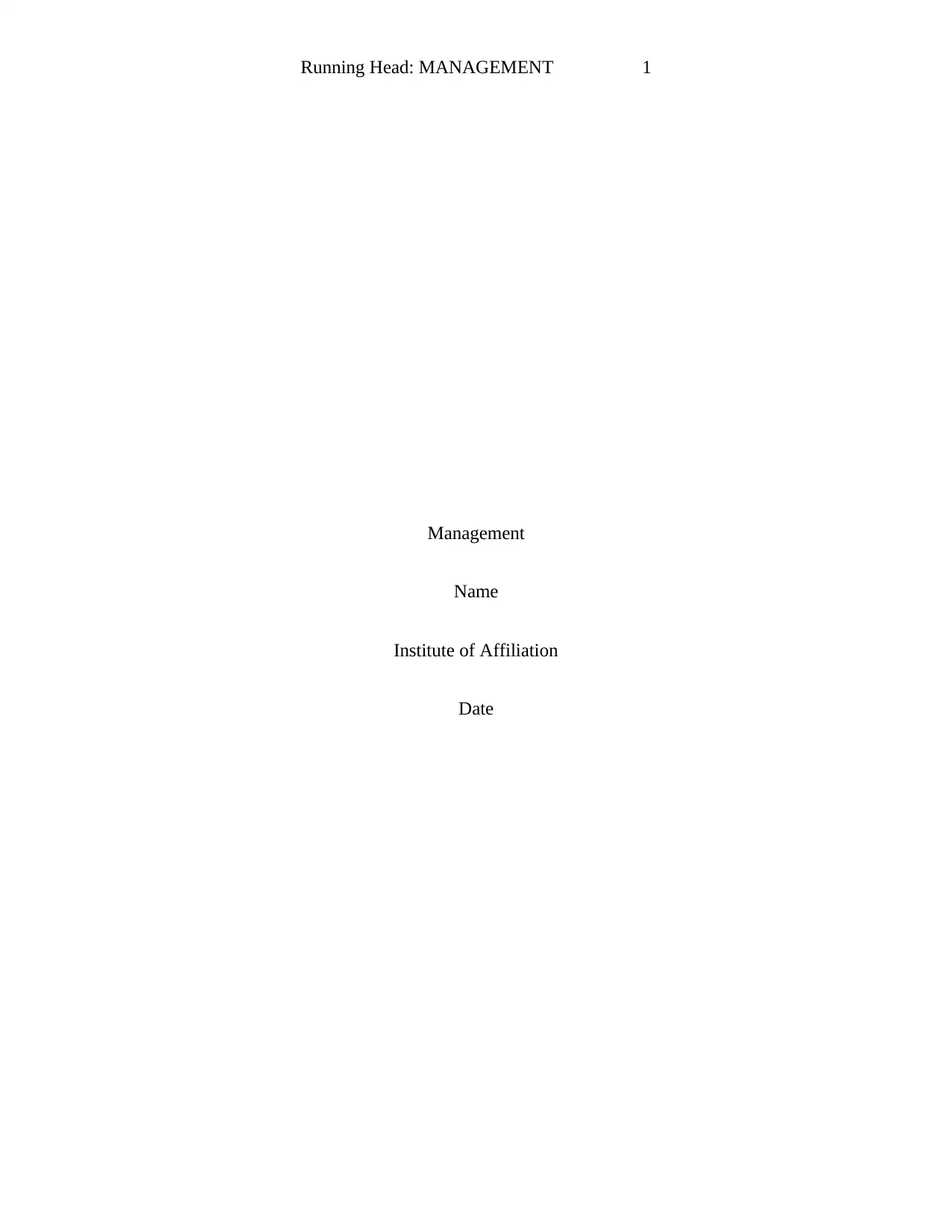
Running Head: MANAGEMENT 1
Management
Name
Institute of Affiliation
Date
Management
Name
Institute of Affiliation
Date
Paraphrase This Document
Need a fresh take? Get an instant paraphrase of this document with our AI Paraphraser
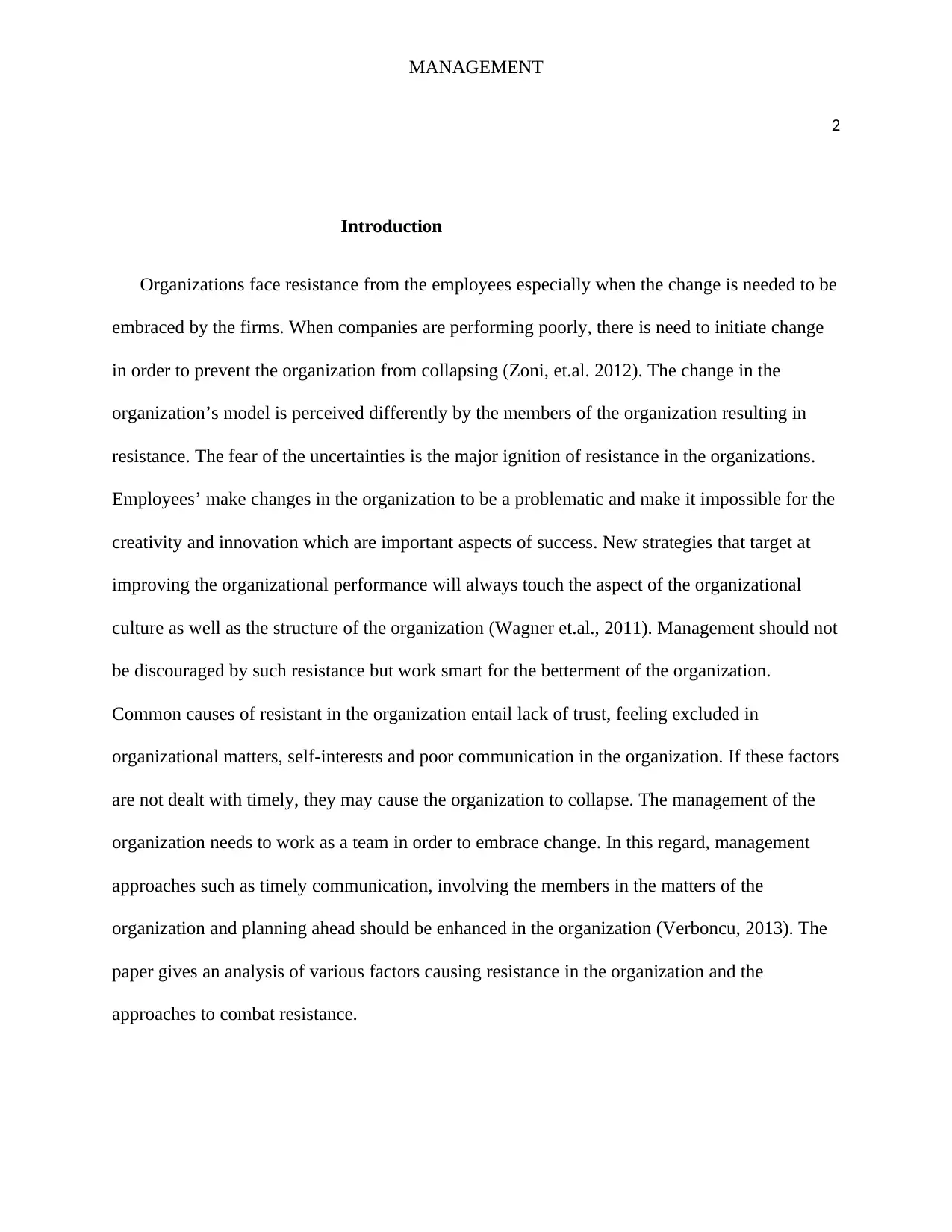
MANAGEMENT
2
Introduction
Organizations face resistance from the employees especially when the change is needed to be
embraced by the firms. When companies are performing poorly, there is need to initiate change
in order to prevent the organization from collapsing (Zoni, et.al. 2012). The change in the
organization’s model is perceived differently by the members of the organization resulting in
resistance. The fear of the uncertainties is the major ignition of resistance in the organizations.
Employees’ make changes in the organization to be a problematic and make it impossible for the
creativity and innovation which are important aspects of success. New strategies that target at
improving the organizational performance will always touch the aspect of the organizational
culture as well as the structure of the organization (Wagner et.al., 2011). Management should not
be discouraged by such resistance but work smart for the betterment of the organization.
Common causes of resistant in the organization entail lack of trust, feeling excluded in
organizational matters, self-interests and poor communication in the organization. If these factors
are not dealt with timely, they may cause the organization to collapse. The management of the
organization needs to work as a team in order to embrace change. In this regard, management
approaches such as timely communication, involving the members in the matters of the
organization and planning ahead should be enhanced in the organization (Verboncu, 2013). The
paper gives an analysis of various factors causing resistance in the organization and the
approaches to combat resistance.
2
Introduction
Organizations face resistance from the employees especially when the change is needed to be
embraced by the firms. When companies are performing poorly, there is need to initiate change
in order to prevent the organization from collapsing (Zoni, et.al. 2012). The change in the
organization’s model is perceived differently by the members of the organization resulting in
resistance. The fear of the uncertainties is the major ignition of resistance in the organizations.
Employees’ make changes in the organization to be a problematic and make it impossible for the
creativity and innovation which are important aspects of success. New strategies that target at
improving the organizational performance will always touch the aspect of the organizational
culture as well as the structure of the organization (Wagner et.al., 2011). Management should not
be discouraged by such resistance but work smart for the betterment of the organization.
Common causes of resistant in the organization entail lack of trust, feeling excluded in
organizational matters, self-interests and poor communication in the organization. If these factors
are not dealt with timely, they may cause the organization to collapse. The management of the
organization needs to work as a team in order to embrace change. In this regard, management
approaches such as timely communication, involving the members in the matters of the
organization and planning ahead should be enhanced in the organization (Verboncu, 2013). The
paper gives an analysis of various factors causing resistance in the organization and the
approaches to combat resistance.
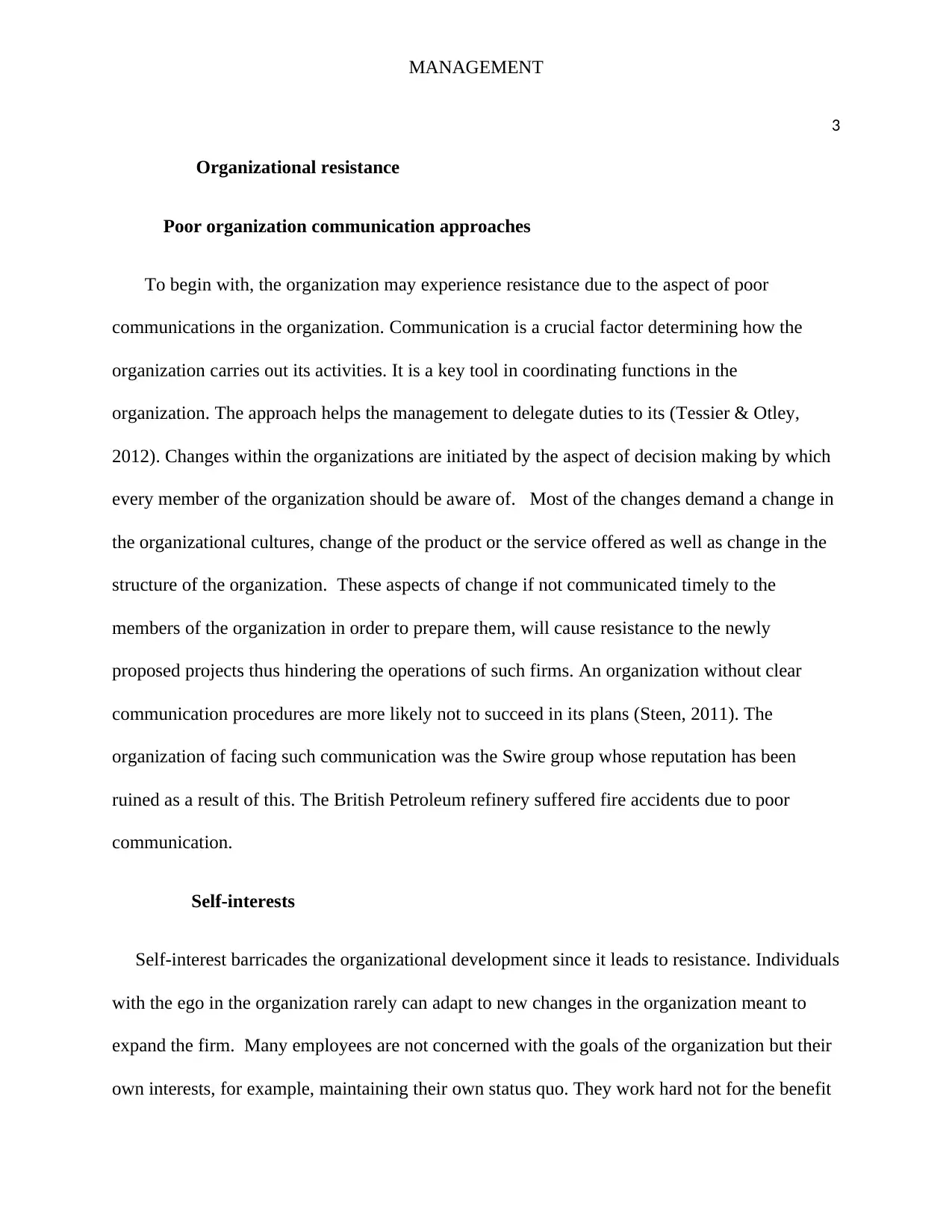
MANAGEMENT
3
Organizational resistance
Poor organization communication approaches
To begin with, the organization may experience resistance due to the aspect of poor
communications in the organization. Communication is a crucial factor determining how the
organization carries out its activities. It is a key tool in coordinating functions in the
organization. The approach helps the management to delegate duties to its (Tessier & Otley,
2012). Changes within the organizations are initiated by the aspect of decision making by which
every member of the organization should be aware of. Most of the changes demand a change in
the organizational cultures, change of the product or the service offered as well as change in the
structure of the organization. These aspects of change if not communicated timely to the
members of the organization in order to prepare them, will cause resistance to the newly
proposed projects thus hindering the operations of such firms. An organization without clear
communication procedures are more likely not to succeed in its plans (Steen, 2011). The
organization of facing such communication was the Swire group whose reputation has been
ruined as a result of this. The British Petroleum refinery suffered fire accidents due to poor
communication.
Self-interests
Self-interest barricades the organizational development since it leads to resistance. Individuals
with the ego in the organization rarely can adapt to new changes in the organization meant to
expand the firm. Many employees are not concerned with the goals of the organization but their
own interests, for example, maintaining their own status quo. They work hard not for the benefit
3
Organizational resistance
Poor organization communication approaches
To begin with, the organization may experience resistance due to the aspect of poor
communications in the organization. Communication is a crucial factor determining how the
organization carries out its activities. It is a key tool in coordinating functions in the
organization. The approach helps the management to delegate duties to its (Tessier & Otley,
2012). Changes within the organizations are initiated by the aspect of decision making by which
every member of the organization should be aware of. Most of the changes demand a change in
the organizational cultures, change of the product or the service offered as well as change in the
structure of the organization. These aspects of change if not communicated timely to the
members of the organization in order to prepare them, will cause resistance to the newly
proposed projects thus hindering the operations of such firms. An organization without clear
communication procedures are more likely not to succeed in its plans (Steen, 2011). The
organization of facing such communication was the Swire group whose reputation has been
ruined as a result of this. The British Petroleum refinery suffered fire accidents due to poor
communication.
Self-interests
Self-interest barricades the organizational development since it leads to resistance. Individuals
with the ego in the organization rarely can adapt to new changes in the organization meant to
expand the firm. Many employees are not concerned with the goals of the organization but their
own interests, for example, maintaining their own status quo. They work hard not for the benefit
⊘ This is a preview!⊘
Do you want full access?
Subscribe today to unlock all pages.

Trusted by 1+ million students worldwide
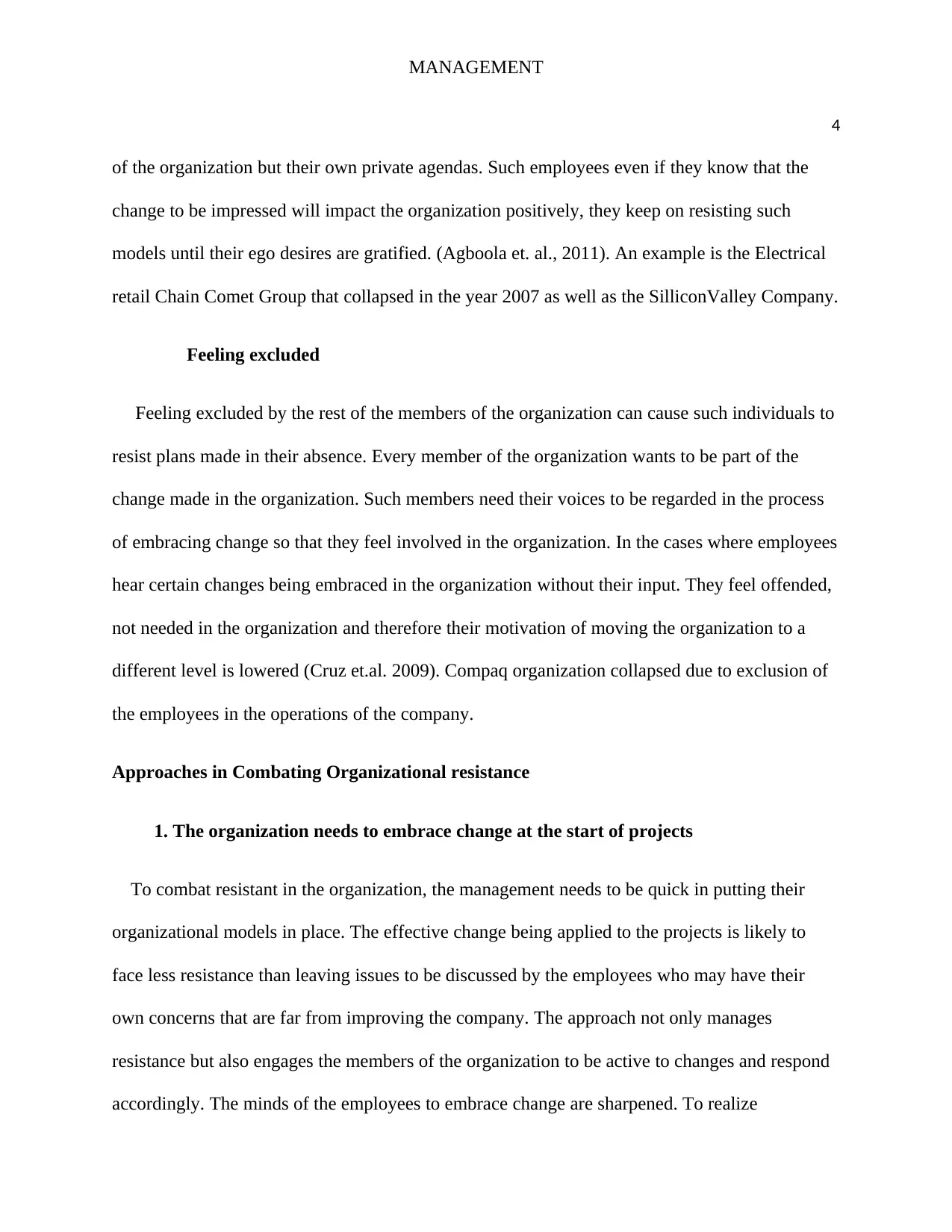
MANAGEMENT
4
of the organization but their own private agendas. Such employees even if they know that the
change to be impressed will impact the organization positively, they keep on resisting such
models until their ego desires are gratified. (Agboola et. al., 2011). An example is the Electrical
retail Chain Comet Group that collapsed in the year 2007 as well as the SilliconValley Company.
Feeling excluded
Feeling excluded by the rest of the members of the organization can cause such individuals to
resist plans made in their absence. Every member of the organization wants to be part of the
change made in the organization. Such members need their voices to be regarded in the process
of embracing change so that they feel involved in the organization. In the cases where employees
hear certain changes being embraced in the organization without their input. They feel offended,
not needed in the organization and therefore their motivation of moving the organization to a
different level is lowered (Cruz et.al. 2009). Compaq organization collapsed due to exclusion of
the employees in the operations of the company.
Approaches in Combating Organizational resistance
1. The organization needs to embrace change at the start of projects
To combat resistant in the organization, the management needs to be quick in putting their
organizational models in place. The effective change being applied to the projects is likely to
face less resistance than leaving issues to be discussed by the employees who may have their
own concerns that are far from improving the company. The approach not only manages
resistance but also engages the members of the organization to be active to changes and respond
accordingly. The minds of the employees to embrace change are sharpened. To realize
4
of the organization but their own private agendas. Such employees even if they know that the
change to be impressed will impact the organization positively, they keep on resisting such
models until their ego desires are gratified. (Agboola et. al., 2011). An example is the Electrical
retail Chain Comet Group that collapsed in the year 2007 as well as the SilliconValley Company.
Feeling excluded
Feeling excluded by the rest of the members of the organization can cause such individuals to
resist plans made in their absence. Every member of the organization wants to be part of the
change made in the organization. Such members need their voices to be regarded in the process
of embracing change so that they feel involved in the organization. In the cases where employees
hear certain changes being embraced in the organization without their input. They feel offended,
not needed in the organization and therefore their motivation of moving the organization to a
different level is lowered (Cruz et.al. 2009). Compaq organization collapsed due to exclusion of
the employees in the operations of the company.
Approaches in Combating Organizational resistance
1. The organization needs to embrace change at the start of projects
To combat resistant in the organization, the management needs to be quick in putting their
organizational models in place. The effective change being applied to the projects is likely to
face less resistance than leaving issues to be discussed by the employees who may have their
own concerns that are far from improving the company. The approach not only manages
resistance but also engages the members of the organization to be active to changes and respond
accordingly. The minds of the employees to embrace change are sharpened. To realize
Paraphrase This Document
Need a fresh take? Get an instant paraphrase of this document with our AI Paraphraser
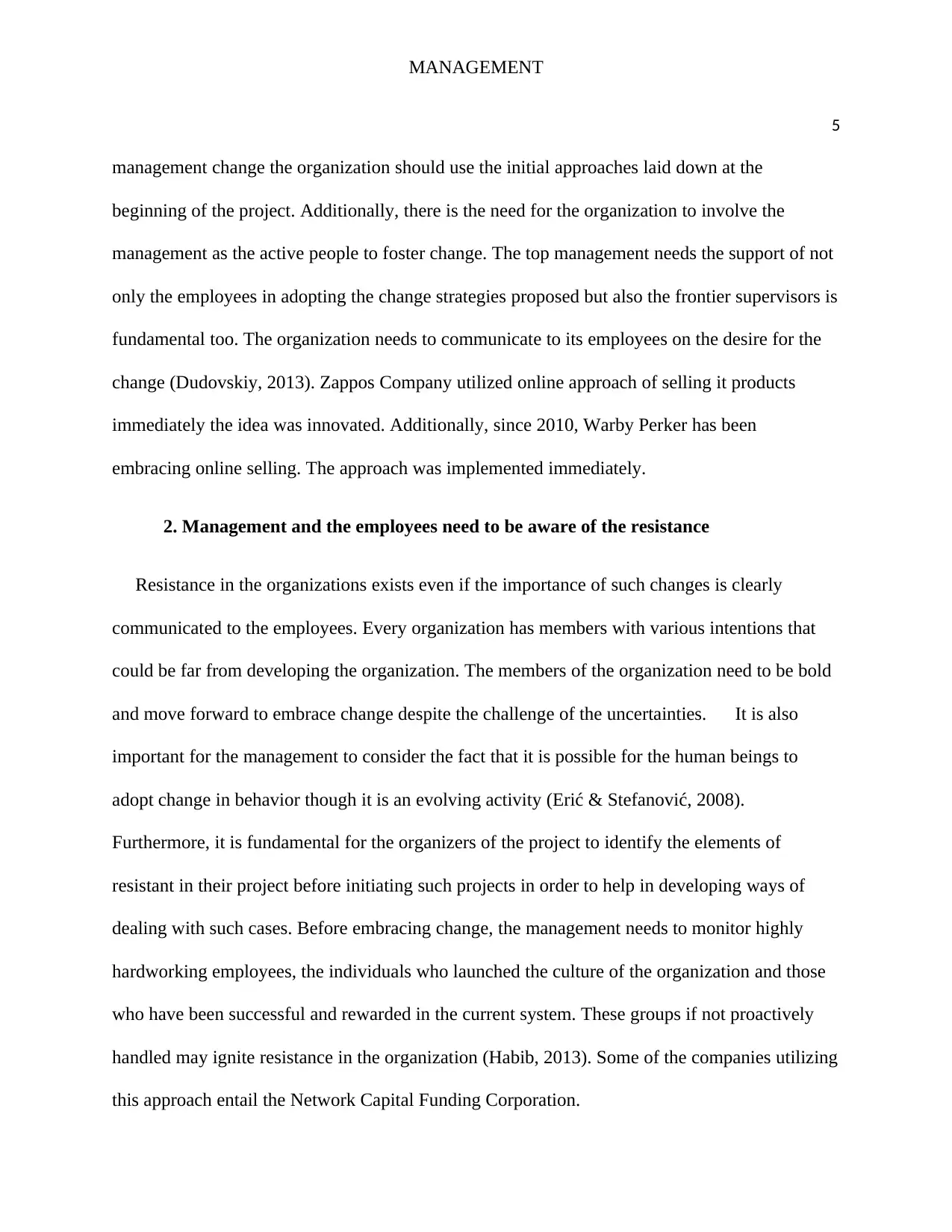
MANAGEMENT
5
management change the organization should use the initial approaches laid down at the
beginning of the project. Additionally, there is the need for the organization to involve the
management as the active people to foster change. The top management needs the support of not
only the employees in adopting the change strategies proposed but also the frontier supervisors is
fundamental too. The organization needs to communicate to its employees on the desire for the
change (Dudovskiy, 2013). Zappos Company utilized online approach of selling it products
immediately the idea was innovated. Additionally, since 2010, Warby Perker has been
embracing online selling. The approach was implemented immediately.
2. Management and the employees need to be aware of the resistance
Resistance in the organizations exists even if the importance of such changes is clearly
communicated to the employees. Every organization has members with various intentions that
could be far from developing the organization. The members of the organization need to be bold
and move forward to embrace change despite the challenge of the uncertainties. It is also
important for the management to consider the fact that it is possible for the human beings to
adopt change in behavior though it is an evolving activity (Erić & Stefanović, 2008).
Furthermore, it is fundamental for the organizers of the project to identify the elements of
resistant in their project before initiating such projects in order to help in developing ways of
dealing with such cases. Before embracing change, the management needs to monitor highly
hardworking employees, the individuals who launched the culture of the organization and those
who have been successful and rewarded in the current system. These groups if not proactively
handled may ignite resistance in the organization (Habib, 2013). Some of the companies utilizing
this approach entail the Network Capital Funding Corporation.
5
management change the organization should use the initial approaches laid down at the
beginning of the project. Additionally, there is the need for the organization to involve the
management as the active people to foster change. The top management needs the support of not
only the employees in adopting the change strategies proposed but also the frontier supervisors is
fundamental too. The organization needs to communicate to its employees on the desire for the
change (Dudovskiy, 2013). Zappos Company utilized online approach of selling it products
immediately the idea was innovated. Additionally, since 2010, Warby Perker has been
embracing online selling. The approach was implemented immediately.
2. Management and the employees need to be aware of the resistance
Resistance in the organizations exists even if the importance of such changes is clearly
communicated to the employees. Every organization has members with various intentions that
could be far from developing the organization. The members of the organization need to be bold
and move forward to embrace change despite the challenge of the uncertainties. It is also
important for the management to consider the fact that it is possible for the human beings to
adopt change in behavior though it is an evolving activity (Erić & Stefanović, 2008).
Furthermore, it is fundamental for the organizers of the project to identify the elements of
resistant in their project before initiating such projects in order to help in developing ways of
dealing with such cases. Before embracing change, the management needs to monitor highly
hardworking employees, the individuals who launched the culture of the organization and those
who have been successful and rewarded in the current system. These groups if not proactively
handled may ignite resistance in the organization (Habib, 2013). Some of the companies utilizing
this approach entail the Network Capital Funding Corporation.
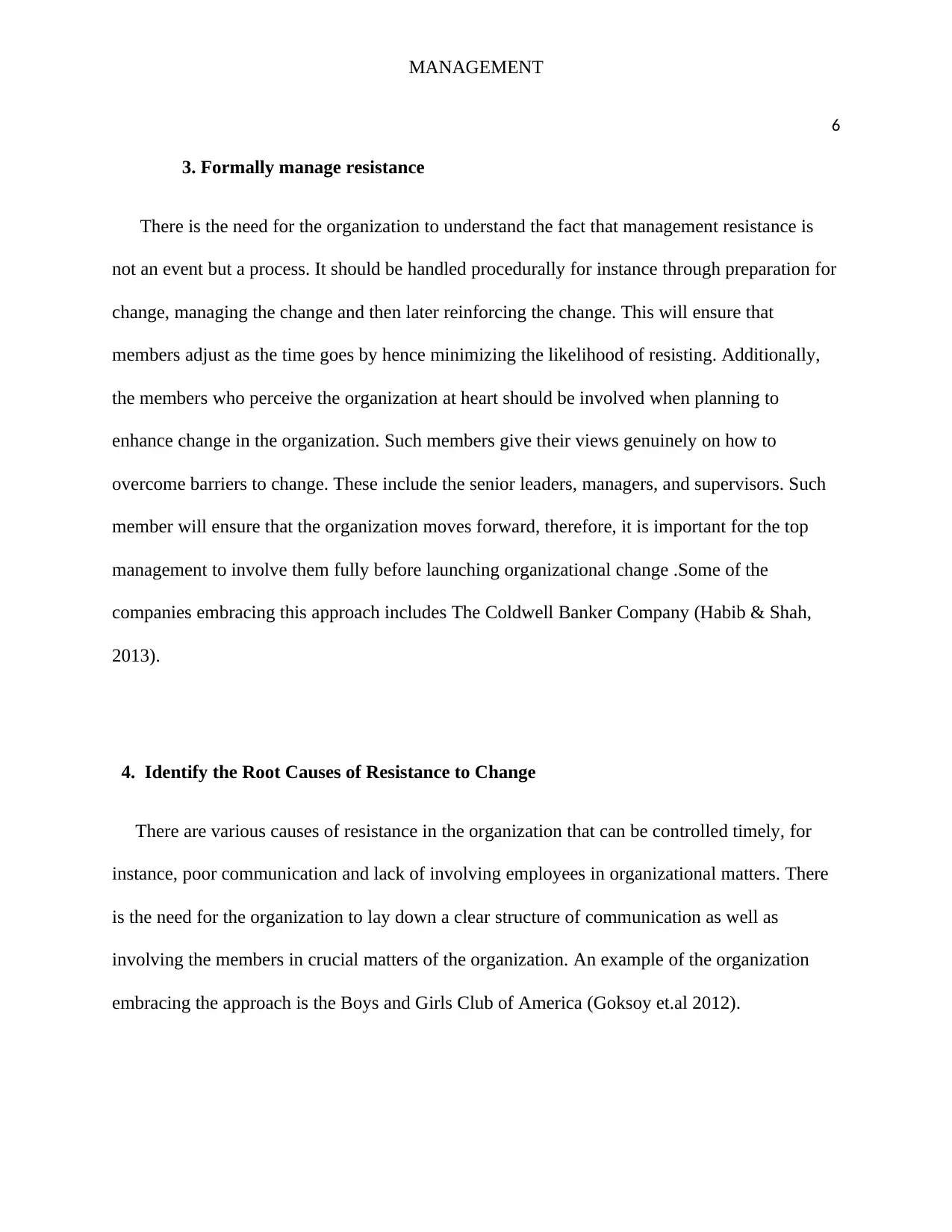
MANAGEMENT
6
3. Formally manage resistance
There is the need for the organization to understand the fact that management resistance is
not an event but a process. It should be handled procedurally for instance through preparation for
change, managing the change and then later reinforcing the change. This will ensure that
members adjust as the time goes by hence minimizing the likelihood of resisting. Additionally,
the members who perceive the organization at heart should be involved when planning to
enhance change in the organization. Such members give their views genuinely on how to
overcome barriers to change. These include the senior leaders, managers, and supervisors. Such
member will ensure that the organization moves forward, therefore, it is important for the top
management to involve them fully before launching organizational change .Some of the
companies embracing this approach includes The Coldwell Banker Company (Habib & Shah,
2013).
4. Identify the Root Causes of Resistance to Change
There are various causes of resistance in the organization that can be controlled timely, for
instance, poor communication and lack of involving employees in organizational matters. There
is the need for the organization to lay down a clear structure of communication as well as
involving the members in crucial matters of the organization. An example of the organization
embracing the approach is the Boys and Girls Club of America (Goksoy et.al 2012).
6
3. Formally manage resistance
There is the need for the organization to understand the fact that management resistance is
not an event but a process. It should be handled procedurally for instance through preparation for
change, managing the change and then later reinforcing the change. This will ensure that
members adjust as the time goes by hence minimizing the likelihood of resisting. Additionally,
the members who perceive the organization at heart should be involved when planning to
enhance change in the organization. Such members give their views genuinely on how to
overcome barriers to change. These include the senior leaders, managers, and supervisors. Such
member will ensure that the organization moves forward, therefore, it is important for the top
management to involve them fully before launching organizational change .Some of the
companies embracing this approach includes The Coldwell Banker Company (Habib & Shah,
2013).
4. Identify the Root Causes of Resistance to Change
There are various causes of resistance in the organization that can be controlled timely, for
instance, poor communication and lack of involving employees in organizational matters. There
is the need for the organization to lay down a clear structure of communication as well as
involving the members in crucial matters of the organization. An example of the organization
embracing the approach is the Boys and Girls Club of America (Goksoy et.al 2012).
⊘ This is a preview!⊘
Do you want full access?
Subscribe today to unlock all pages.

Trusted by 1+ million students worldwide
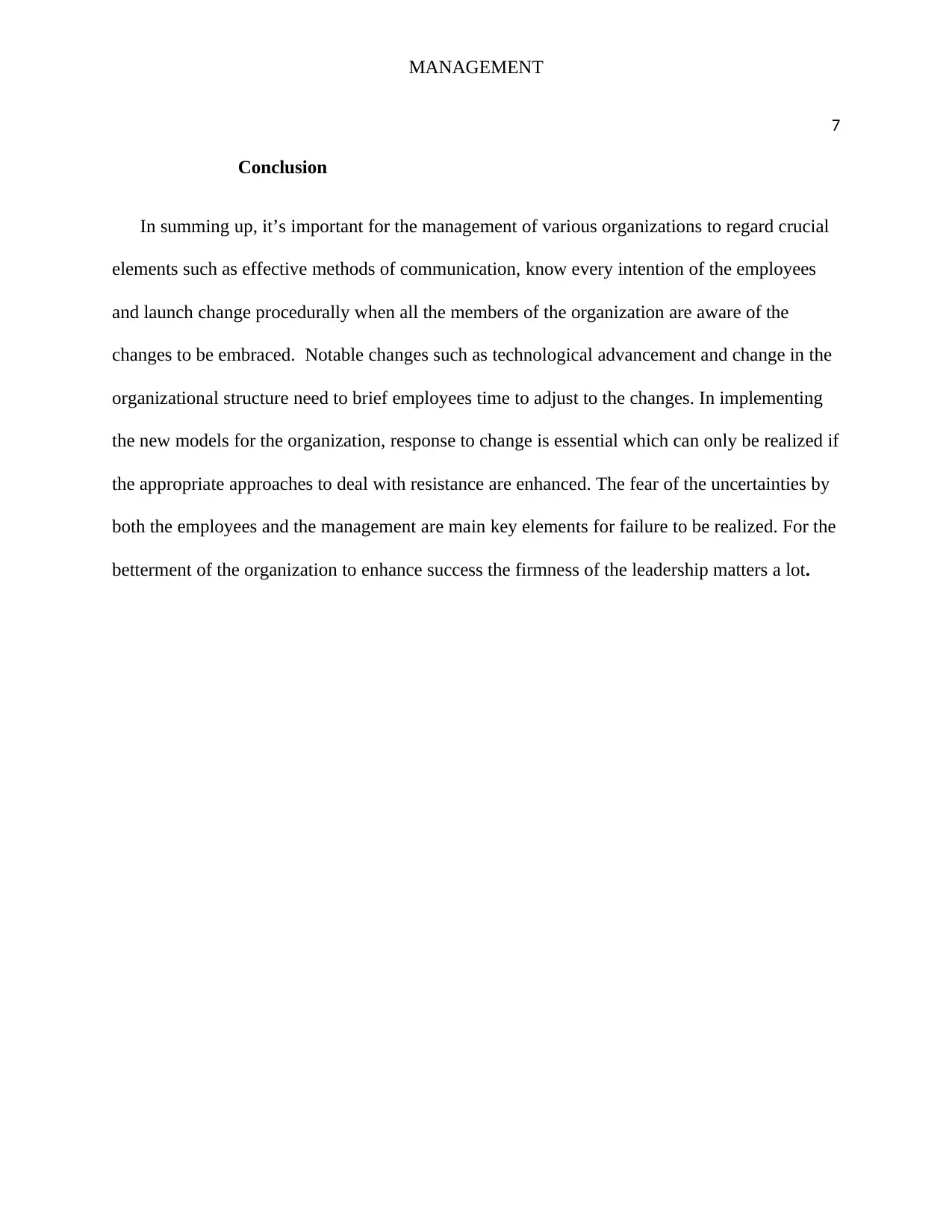
MANAGEMENT
7
Conclusion
In summing up, it’s important for the management of various organizations to regard crucial
elements such as effective methods of communication, know every intention of the employees
and launch change procedurally when all the members of the organization are aware of the
changes to be embraced. Notable changes such as technological advancement and change in the
organizational structure need to brief employees time to adjust to the changes. In implementing
the new models for the organization, response to change is essential which can only be realized if
the appropriate approaches to deal with resistance are enhanced. The fear of the uncertainties by
both the employees and the management are main key elements for failure to be realized. For the
betterment of the organization to enhance success the firmness of the leadership matters a lot.
7
Conclusion
In summing up, it’s important for the management of various organizations to regard crucial
elements such as effective methods of communication, know every intention of the employees
and launch change procedurally when all the members of the organization are aware of the
changes to be embraced. Notable changes such as technological advancement and change in the
organizational structure need to brief employees time to adjust to the changes. In implementing
the new models for the organization, response to change is essential which can only be realized if
the appropriate approaches to deal with resistance are enhanced. The fear of the uncertainties by
both the employees and the management are main key elements for failure to be realized. For the
betterment of the organization to enhance success the firmness of the leadership matters a lot.
Paraphrase This Document
Need a fresh take? Get an instant paraphrase of this document with our AI Paraphraser
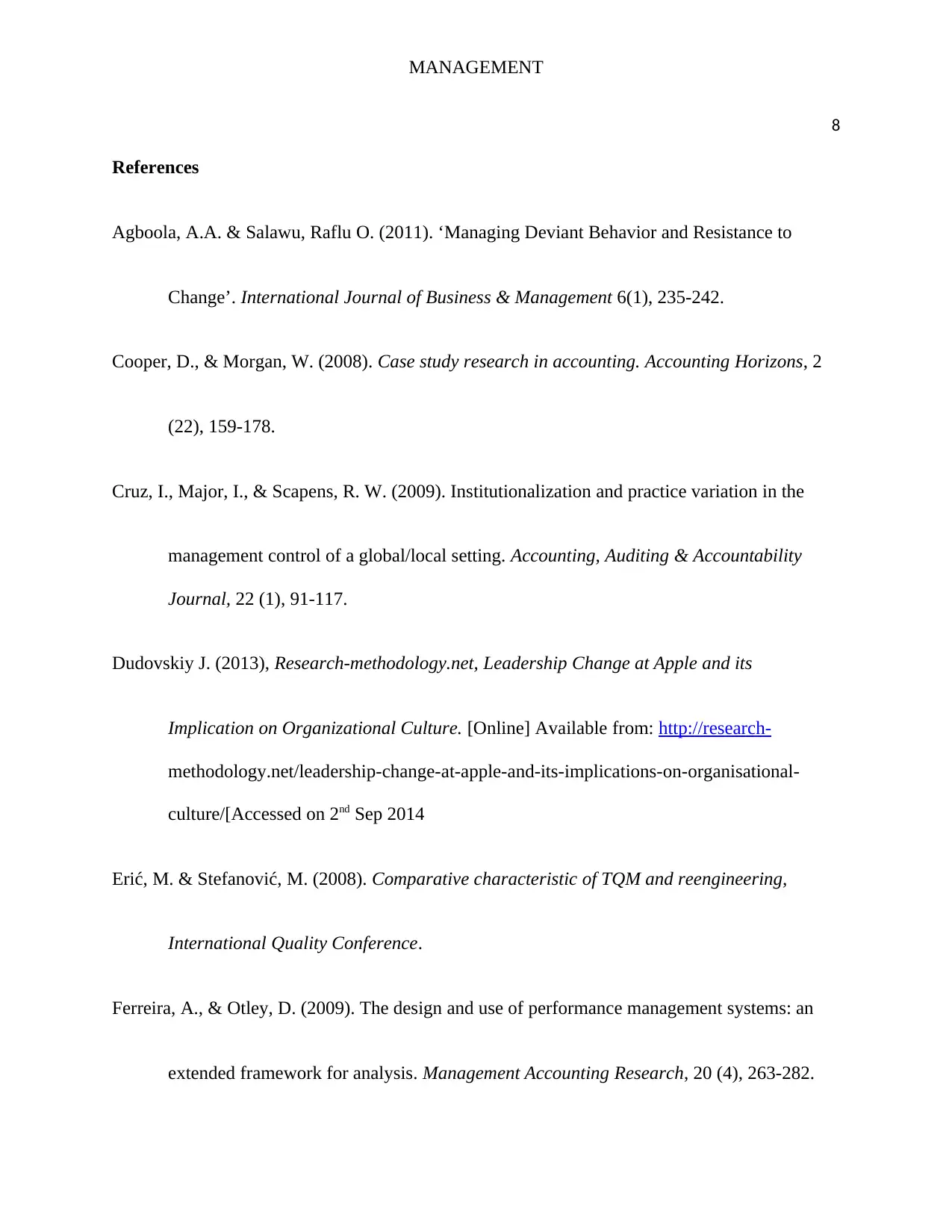
MANAGEMENT
8
References
Agboola, A.A. & Salawu, Raflu O. (2011). ‘Managing Deviant Behavior and Resistance to
Change’. International Journal of Business & Management 6(1), 235-242.
Cooper, D., & Morgan, W. (2008). Case study research in accounting. Accounting Horizons, 2
(22), 159-178.
Cruz, I., Major, I., & Scapens, R. W. (2009). Institutionalization and practice variation in the
management control of a global/local setting. Accounting, Auditing & Accountability
Journal, 22 (1), 91-117.
Dudovskiy J. (2013), Research-methodology.net, Leadership Change at Apple and its
Implication on Organizational Culture. [Online] Available from: http://research-
methodology.net/leadership-change-at-apple-and-its-implications-on-organisational-
culture/[Accessed on 2nd Sep 2014
Erić, M. & Stefanović, M. (2008). Comparative characteristic of TQM and reengineering,
International Quality Conference.
Ferreira, A., & Otley, D. (2009). The design and use of performance management systems: an
extended framework for analysis. Management Accounting Research, 20 (4), 263-282.
8
References
Agboola, A.A. & Salawu, Raflu O. (2011). ‘Managing Deviant Behavior and Resistance to
Change’. International Journal of Business & Management 6(1), 235-242.
Cooper, D., & Morgan, W. (2008). Case study research in accounting. Accounting Horizons, 2
(22), 159-178.
Cruz, I., Major, I., & Scapens, R. W. (2009). Institutionalization and practice variation in the
management control of a global/local setting. Accounting, Auditing & Accountability
Journal, 22 (1), 91-117.
Dudovskiy J. (2013), Research-methodology.net, Leadership Change at Apple and its
Implication on Organizational Culture. [Online] Available from: http://research-
methodology.net/leadership-change-at-apple-and-its-implications-on-organisational-
culture/[Accessed on 2nd Sep 2014
Erić, M. & Stefanović, M. (2008). Comparative characteristic of TQM and reengineering,
International Quality Conference.
Ferreira, A., & Otley, D. (2009). The design and use of performance management systems: an
extended framework for analysis. Management Accounting Research, 20 (4), 263-282.
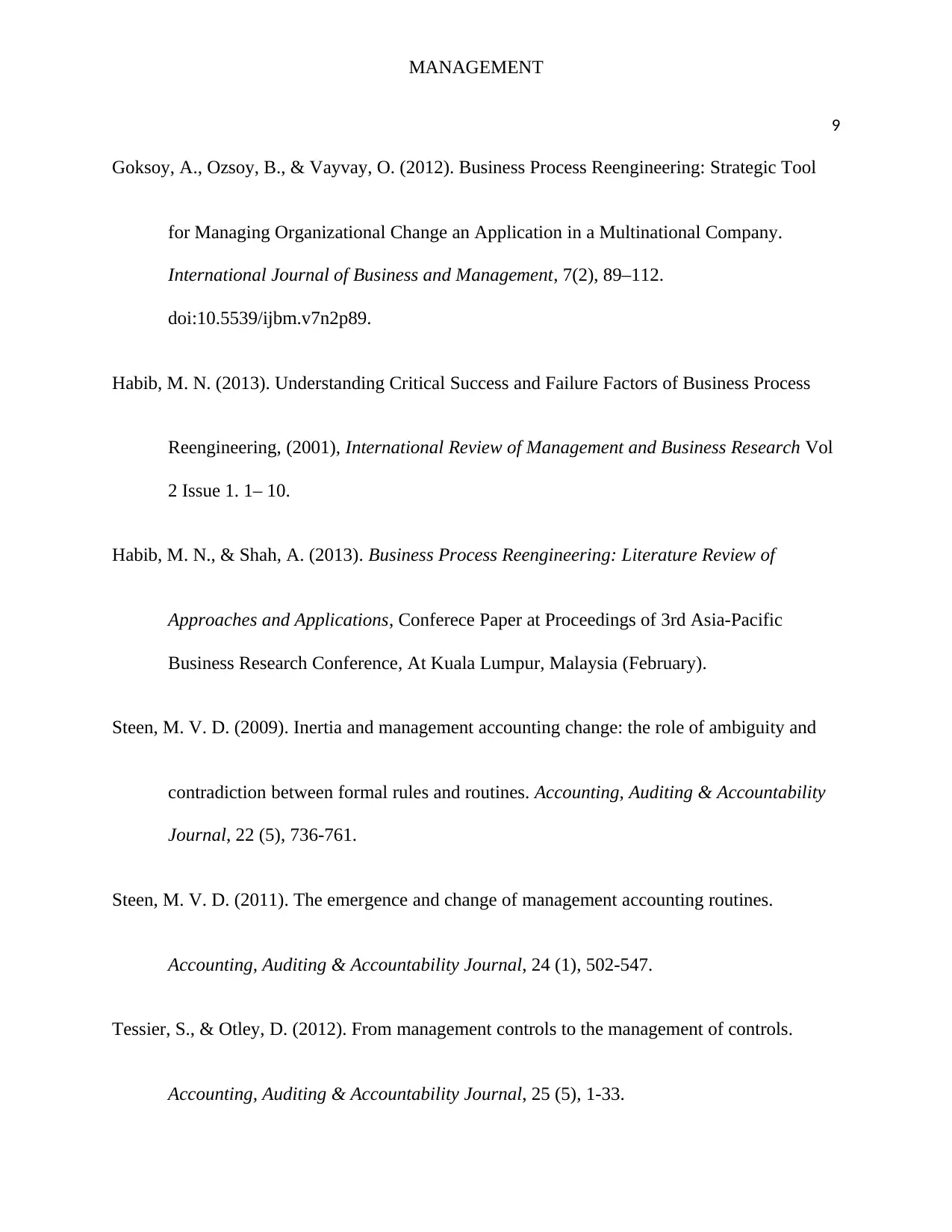
MANAGEMENT
9
Goksoy, A., Ozsoy, B., & Vayvay, O. (2012). Business Process Reengineering: Strategic Tool
for Managing Organizational Change an Application in a Multinational Company.
International Journal of Business and Management, 7(2), 89–112.
doi:10.5539/ijbm.v7n2p89.
Habib, M. N. (2013). Understanding Critical Success and Failure Factors of Business Process
Reengineering, (2001), International Review of Management and Business Research Vol
2 Issue 1. 1– 10.
Habib, M. N., & Shah, A. (2013). Business Process Reengineering: Literature Review of
Approaches and Applications, Conferece Paper at Proceedings of 3rd Asia-Pacific
Business Research Conference, At Kuala Lumpur, Malaysia (February).
Steen, M. V. D. (2009). Inertia and management accounting change: the role of ambiguity and
contradiction between formal rules and routines. Accounting, Auditing & Accountability
Journal, 22 (5), 736-761.
Steen, M. V. D. (2011). The emergence and change of management accounting routines.
Accounting, Auditing & Accountability Journal, 24 (1), 502-547.
Tessier, S., & Otley, D. (2012). From management controls to the management of controls.
Accounting, Auditing & Accountability Journal, 25 (5), 1-33.
9
Goksoy, A., Ozsoy, B., & Vayvay, O. (2012). Business Process Reengineering: Strategic Tool
for Managing Organizational Change an Application in a Multinational Company.
International Journal of Business and Management, 7(2), 89–112.
doi:10.5539/ijbm.v7n2p89.
Habib, M. N. (2013). Understanding Critical Success and Failure Factors of Business Process
Reengineering, (2001), International Review of Management and Business Research Vol
2 Issue 1. 1– 10.
Habib, M. N., & Shah, A. (2013). Business Process Reengineering: Literature Review of
Approaches and Applications, Conferece Paper at Proceedings of 3rd Asia-Pacific
Business Research Conference, At Kuala Lumpur, Malaysia (February).
Steen, M. V. D. (2009). Inertia and management accounting change: the role of ambiguity and
contradiction between formal rules and routines. Accounting, Auditing & Accountability
Journal, 22 (5), 736-761.
Steen, M. V. D. (2011). The emergence and change of management accounting routines.
Accounting, Auditing & Accountability Journal, 24 (1), 502-547.
Tessier, S., & Otley, D. (2012). From management controls to the management of controls.
Accounting, Auditing & Accountability Journal, 25 (5), 1-33.
⊘ This is a preview!⊘
Do you want full access?
Subscribe today to unlock all pages.

Trusted by 1+ million students worldwide
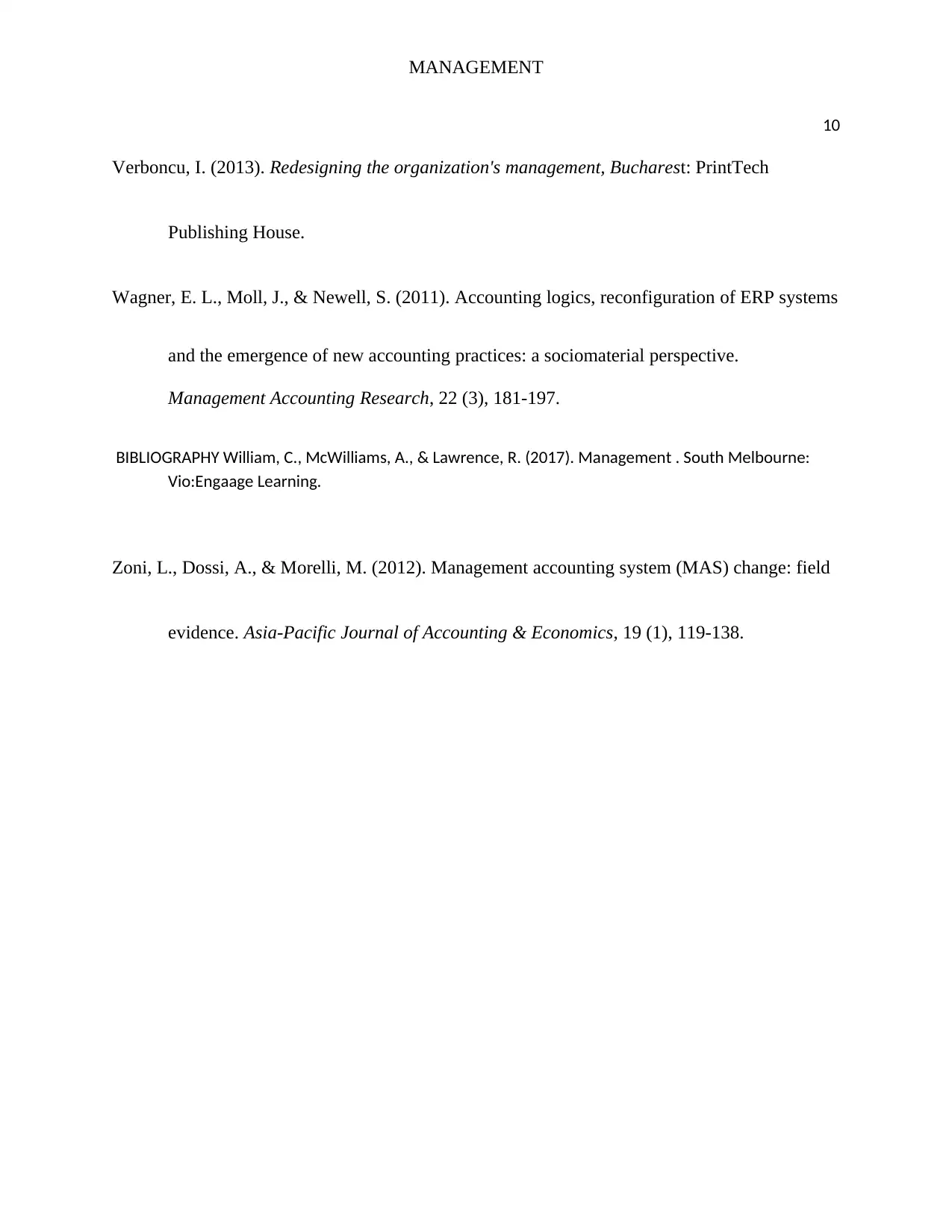
MANAGEMENT
10
Verboncu, I. (2013). Redesigning the organization's management, Bucharest: PrintTech
Publishing House.
Wagner, E. L., Moll, J., & Newell, S. (2011). Accounting logics, reconfiguration of ERP systems
and the emergence of new accounting practices: a sociomaterial perspective.
Management Accounting Research, 22 (3), 181-197.
BIBLIOGRAPHY William, C., McWilliams, A., & Lawrence, R. (2017). Management . South Melbourne:
Vio:Engaage Learning.
Zoni, L., Dossi, A., & Morelli, M. (2012). Management accounting system (MAS) change: field
evidence. Asia-Pacific Journal of Accounting & Economics, 19 (1), 119-138.
10
Verboncu, I. (2013). Redesigning the organization's management, Bucharest: PrintTech
Publishing House.
Wagner, E. L., Moll, J., & Newell, S. (2011). Accounting logics, reconfiguration of ERP systems
and the emergence of new accounting practices: a sociomaterial perspective.
Management Accounting Research, 22 (3), 181-197.
BIBLIOGRAPHY William, C., McWilliams, A., & Lawrence, R. (2017). Management . South Melbourne:
Vio:Engaage Learning.
Zoni, L., Dossi, A., & Morelli, M. (2012). Management accounting system (MAS) change: field
evidence. Asia-Pacific Journal of Accounting & Economics, 19 (1), 119-138.
1 out of 10
Related Documents
Your All-in-One AI-Powered Toolkit for Academic Success.
+13062052269
info@desklib.com
Available 24*7 on WhatsApp / Email
![[object Object]](/_next/static/media/star-bottom.7253800d.svg)
Unlock your academic potential
Copyright © 2020–2025 A2Z Services. All Rights Reserved. Developed and managed by ZUCOL.





